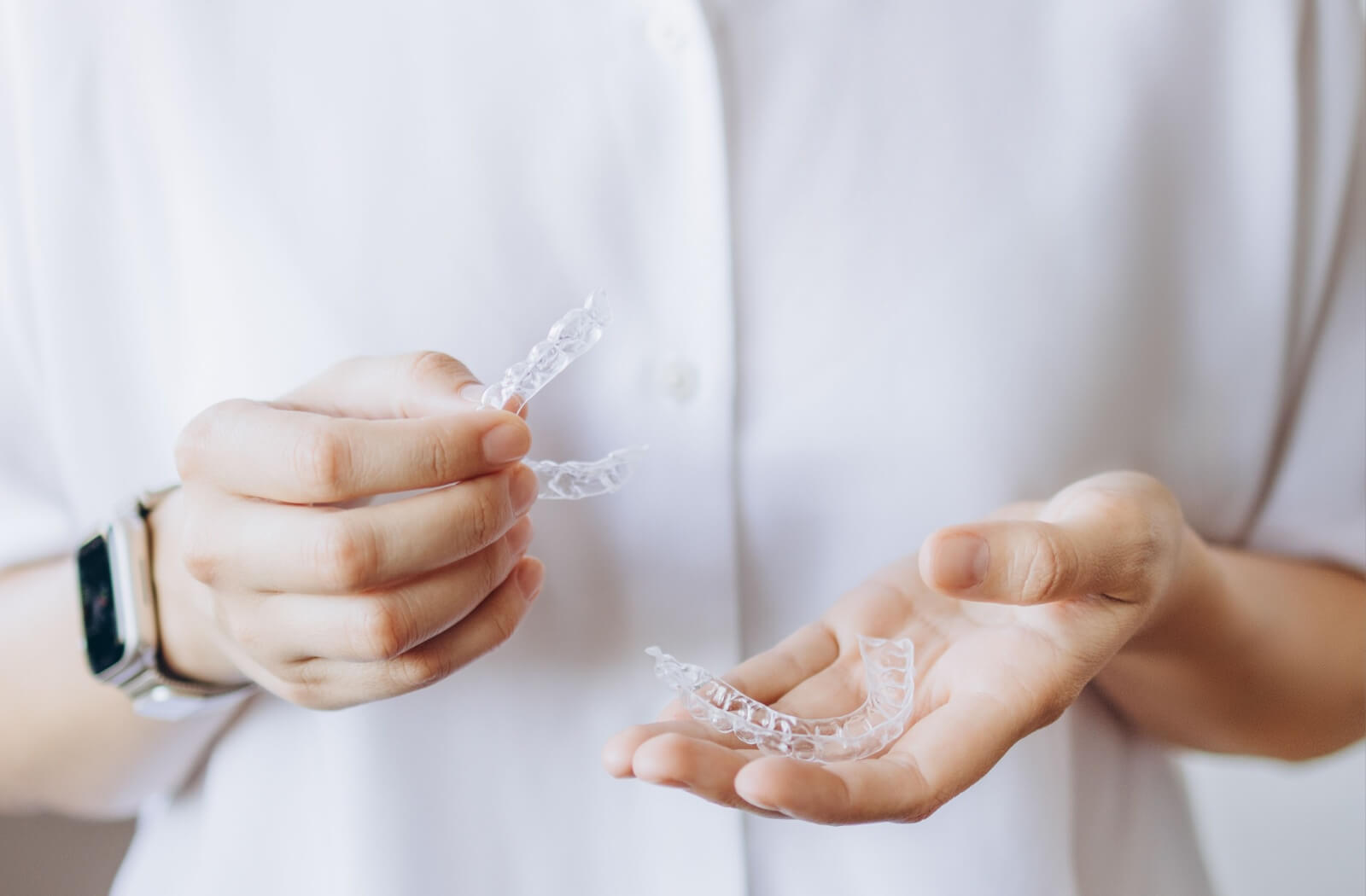
If you’re considering orthodontic treatment to straighten your teeth, you might be curious which option will achieve faster results—Invisalign or braces. Every case is unique, but Invisalign typically works faster for simple, straightforward treatments, while braces may work quicker for complex cases.
With that in mind, there are several reasons why you might choose Invisalign over braces and vice versa. Speaking with a dentist can be a great way to learn about the different treatment options available that might be right for your teeth.
What Are Invisalign & Braces?
Invisalign
Invisalign is an orthodontic treatment that uses a series of clear, removable aligners made from flexible plastic to gradually shift teeth into place. The aligners are custom-made to fit your teeth and typically must be worn for about 20–22 hours daily. They are usually changed every 1–2 weeks as the treatment progresses.
Braces
Traditional braces are made of metal brackets, wires, and sometimes elastic bands that are bonded to the teeth. They use consistent pressure to correct alignment over time. Unlike Invisalign, braces cannot be removed and require regular adjustments by your orthodontist.
Which Option Is Faster?
Invisalign can generally correct specific areas and issues within 6–18 months, whether it be crooked teeth, gaps, crowding, or minor bite issues, often making it the faster option. On the other hand, braces correct issues usually within 18–24 months but can be longer when dealing with more significant issues, such as larger gaps or rotated teeth.
Factors That Can Influence Treatment Time
Regardless of whether you opt for Invisalign or braces, treatment time can vary depending on:
- The complexity of the alignment issue:Minor issues are usually quicker to fix with Invisalign. Whereas, larger and more complex issues are usually best handled with traditional braces.
- Compliance: Invisalign requires wearing aligners for 20–22 hours a day to be effective; failure to follow this guideline can result in longer treatment times. In contrast, braces work passively by being securely attached to the teeth, gradually moving them without the need for constant user compliance.
- Frequency of adjustments:Braces generally require in-person orthodontist visits every 4–6 weeks for adjustments. Invisalign patients get new aligners every 1–2 weeks, which helps move the process along more consistently.

Invisalign or Braces? Other Factors to Consider
Speed isn’t always the only consideration when deciding between Invisalign or braces. Several other factors might play a role in your final decision.
Appearance
Aesthetics and the appearance of your treatment option might affect your decision. For example, those seeking a more discreet option might want to consider Invisalign and its clear aligners. The smooth plastic aligners are often considered more comfortable and less noticeable than the metal brackets that come with traditional braces.
Comfort
Whether you choose Invisalign or braces, you will need to wear them often and consistently, which makes comfort an important consideration. Both options apply pressure to your teeth, which can cause some discomfort. Invisalign is often considered more comfortable because it uses smooth plastic aligners rather than metal brackets and wires.
Cost
While prices vary depending on the provider and location, Invisalign and braces are generally quite similar in price.
Maintenance
With Invisalign, you must remove your aligners before eating or drinking anything besides water. As a result, they can be easier to clean before reinserting. Braces are a bit more challenging to clean, requiring special dental tools and techniques to get in between the brackets and wires.
When Do You Need Invisalign or Braces?
Misaligned teeth can affect not only the aesthetics of your smile but also your overall oral health. While the need for orthodontic treatment might vary depending on the person and their circumstances, several common factors should be considered.
- Improving dental health:Crooked or crowded teeth can create hard-to-reach places where plaque and food particles can accumulate. This may increase the risk of tooth decay and gum disease and cause bad breath.
- Aesthetics:A confident smile can boost self-esteem and improve your self-confidence. Invisalign and braces may help to correct misaligned teeth, close gaps, and align your bite for a more balanced smile.
- Bite issues: An improper bite may lead to difficulty with chewing, speech impediments, or discomfort in the jaw. Orthodontic treatment can help to align your bite and resolve these issues.
- Dental wear and tear:Misaligned teeth can cause excessive wear on certain teeth due to the uneven distribution of biting force. Aligning your teeth can prevent premature wear and tear while reducing the likelihood of a chipped or fractured tooth.
Whether you need orthodontic treatment for oral health or aesthetics, Invisalign and braces may offer the solution you seek. Consulting with an orthodontist will provide you with more information and personalized recommendations based on your oral health needs.
Get Advice from Us
If you’re still unsure which treatment is right for your smile, Image Dental Care can help you decide between Invisalign and traditional braces. Our team offers free consultations, during which you can explore both options and learn more about the treatments.
Book an appointment today to get started on your path to a more confident smile!